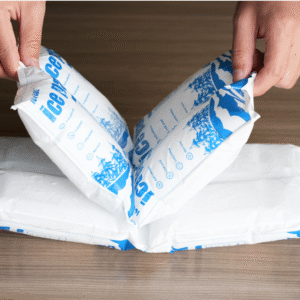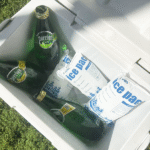Ao enviar itens sensíveis à temperatura como alimentos, espécimes médicos, ou farmacêuticos, Pacotes de gelo seco são uma solução essencial para garantir que permaneçam frios. Aprenda a usar pacotes de gelo seco para enviar em conformidade com o mais recente 2025 regulamentos e práticas recomendadas.
Quanto gelo seco você precisa para corresponder pacotes?
Quais são os últimos regulamentos de envio para gelo seco em 2025?
Como empacotar com segurança o gelo seco para correspondência?
Melhores práticas para manuseio e rotulando remessas de gelo seco
Como evitar riscos de CO₂ durante a correspondência de gelo seco?
Como tamanho Pacotes de gelo seco para correspondência?
Quanto gelo seco você precisa para corresponder pacotes?
Resposta curta:
Para enviar perecíveis ou produtos sensíveis à temperatura, usar 2.5 para 3 libras de gelo seco por pé cúbico de volume da caixa de transporte. Este valor normalmente mantém o conteúdo frio por 48 a 72 horas, Dependendo do tamanho da caixa e temperatura externa. Para remessas mais longas, Aumente o peso do gelo seco.
Explicação expandida:
O gelo seco tem uma vantagem significativa sobre o gelo regular, pois sublima de sólido ao gás, liberando energia substancial. É a solução ideal para remessas de longa distância, especialmente para itens que precisam permanecer congelados ou dentro de uma faixa de temperatura específica.
Dimensionamento de gelo seco para correspondência (Tabela rápida)
| Tamanho da caixa de envio | Gelo Seco (libras) | Tempo de espera | O que isso significa para você |
| Pequeno (10″ x 10″ x 10″) | 2–3 lb. | ~ 48–72 horas | Melhor para pequenos remessas de alimentos ou amostras médicas. |
| Médio (16″ x 16″ x 16″) | 5–7 lb. | ~ 48–72 horas | Para enviar quantidades maiores de comida, vacinas, ou espécimes de laboratório. |
| Grande (24″ x 24″ x 24″) | 10–15 lb. | ~ 72–96 horas | Adequado para remessas médicas em massa, comida, ou várias amostras. |
Para a ponta: Ajustar o peso do gelo seco com base na temperatura externa. Uma temperatura ambiente mais alta fará com que o gelo seco sublime mais rápido, Portanto, adicione mais gelo se o envio durante os meses mais quentes.
Como embalar gelo seco para envio com segurança?
Resposta curta:
Sempre empacote gelo seco em recipientes ventilados para evitar o acúmulo de pressão. Verifique se o pacote permite que o gás Co₂ escape e use a rotulagem adequada para a ONU 1845 e classe 9. Manuseie o gelo seco com luvas isoladas para evitar o congelamento e usar pinças ao colocá -lo no pacote.
Explicação expandida:
Ao embalar gelo seco, É crucial deixar o gás escapar do pacote para evitar acúmulo de pressão perigosa. Siga estas etapas de segurança:
Use um recipiente ventilado: Gelo seco sublima em gás co₂, que precisa escapar. Use caixas ou recipientes projetados para gelo seco com aberturas.
Manuseie com cuidado: Use luvas isoladas ou use pinças, Como o gelo seco é extremamente frio (−78,5 ° C ou −109,3 ° F.) e pode causar um congelamento grave.
Camada corretamente: Coloque o gelo seco no topo dos itens, separado por papelão, espuma, ou embrulho de bolha.
Lista de verificação de embalagem de correspondência de gelo seco:
Cooler ventoso ou contêiner de remessa
Luvas isoladas ou pinças
Camadas de papelão ou espuma para separar o gelo seco
Peso de gelo seco: normalmente 2,5–3 lb por pé cúbico
Rotulagem adequada: E 1845, Aula 9
Madeireiros de temperatura (opcional, mas recomendado para remessas sensíveis)
Quais são os últimos regulamentos de envio para gelo seco em 2025?
Resposta curta:
Instrução de embalagem da IATA 954 (Pi 954) e 49 Os regulamentos de CFR para embalagens de gelo seco aplicam -se a correspondência via transporte aéreo. O gelo seco é classificado como classe 9 bens perigosos e requer rotulagem adequada, ventilação, e limites de peso.
Explicação expandida:
AS 2025, A Associação Internacional de Transporte Aéreo (IATA) e os EUA. Departamento de Transporte (PONTO) têm regulamentos rígidos para o envio de gelo seco, incluindo:
Rotulagem adequada: Aplique a ONU 1845 rótulo, indicando “gelo seco (Dióxido de carbono, Sólido)”E a classe 9 Rótulo de materiais perigosos (100mm quadrado). O peso líquido de gelo seco em kg deve estar claramente marcado.
Embalagem ventilada: Certifique -se de que a embalagem permita que o gás escape para evitar o acúmulo de pressão perigosa.
Documentação de envio: Para transporte aéreo, A declaração de um remetente para mercadorias perigosas é necessária para quantidades sobre 200 kg de gelo seco.
Como o gelo seco se compara a pacotes de gel para correspondência?
Resposta curta:
O gelo seco é muito mais frio que os pacotes de gel, tornando-o ideal para envio de longa duração. Os pacotes de gel são mais fáceis de manusear e não requerem ventilação, tornando-os uma opção mais segura para remessas menores ou de curta duração.
Explicação expandida:
O gelo seco é perfeito para remessas que requerem condições congeladas por períodos prolongados (48+ horas), como vacinas ou suprimentos médicos. Pacotes de gel, por outro lado, são mais adequados para remessas de curto prazo (1–2 dias) e são mais seguros e mais fáceis de lidar.
Gelo seco vs.. Gel Packs para correspondência
| Recurso | Gelo Seco | Pacotes de gel |
| Temperatura | -78,5 ° C. (−109,3 ° F.) | ~ 0 ° C. (32°F) |
| Duração | 48 horas para 96 horas | 1–2 dias |
| Manuseio | Requer luvas, pinças | Não é necessário manuseio especial |
| Melhor para | Remessas congeladas a longo prazo | Remessas resfriadas de curto prazo |
Perguntas frequentes
Q1: Quanto gelo seco eu preciso para enviar comida?
Use 2 a 3 libras por pé cúbico para remessas até 48 horas. Ajuste com base no tempo e na temperatura do envio.
Q2: Posso usar gelo seco para enviar suprimentos médicos?
Sim, O gelo seco é comumente usado para enviar suprimentos médicos. Garanta a ventilação adequada, rotulagem (UN1845), e manuseio.
Q3: Como faço para rotular um pacote com gelo seco?
Marque o pacote com a ONU 1845 e a classe 9 Etiqueta de perigo. Inclua o peso líquido de gelo seco em kg fora da borda da etiqueta.
Resumo e recomendações
Pontos -chave:
O gelo seco é a solução mais eficaz para o envio de mercadorias perecíveis. Garanta a embalagem adequada, dimensionamento correto, e conformidade com os regulamentos. Sempre lide com gelo seco com segurança e siga as mais recentes diretrizes de envio para 2025.
PRÓXIMOS PASSOS:
Calcule suas necessidades de gelo seco com base no tamanho do pacote e na duração do envio.
Use recipientes ventilados e sempre rotule os pacotes corretamente.
Mantenha suas remessas adequadamente isoladas para manter a temperatura.
Sobre Tempk
Tempk é especializado em soluções de embalagem de cadeia fria, fornecendo produtos secos de gelo e temperatura controlada. Nossas soluções atendem aos padrões regulatórios, garantir que seus bens permaneçam em temperaturas ideais durante o trânsito.
























